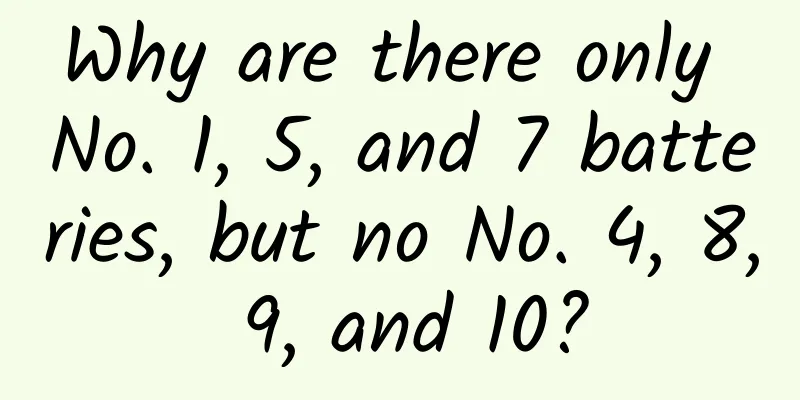Why are there only No. 1, 5, and 7 batteries, but no No. 4, 8, 9, and 10?

|
Audit expert: Wang Jinlu Shenzhen Lingkang Technology Co., Ltd., Power Supply R&D Director A dry cell is a chemical battery that uses a paste electrolyte to generate direct current (a wet cell is a chemical battery that uses a liquid electrolyte). Dry cells are disposable batteries that are commonly used and lightweight in daily life. The most commonly used dry cell is the zinc-manganese dry cell. We often go to the store to buy No. 5 and No. 7 batteries. Have you ever seen batteries with even numbers? Are there only odd numbers for batteries, not even numbers? If so, No. 3 batteries are not seen either. What's going on? Let's take a look with the editor below! Are there only odd numbers for batteries and no even numbers? In fact, when you open Taobao or JD.com and search for the keyword "battery", you will find that batteries from No. 1 to No. 9 are available. So, uncommon does not mean non-existent. Source | Screenshot of an e-commerce platform The main reason is that No. 1, 2, 5, and 7 batteries are commonly used household batteries, especially in remote controls, toys, wall clocks, etc., and are often used in family life, so they give us such a familiar impression. The batteries we talk about in daily life refer to ordinary dry batteries, and their voltage is 1.5V. If you look closely, you can find that the naming of battery numbers follows a certain pattern with the size of the batteries. Battery No. 1 is the largest, battery No. 5 is medium, and battery No. 9 is the smallest. The numbers are usually arranged from large to small according to the size of the batteries. Just like if there are 9 children in a family, the eldest is usually the tallest and the youngest is the shortest. The numbering is used to quickly let others or yourself distinguish them. For example, parents usually introduce their children to others like this: This is my eldest child, that is my second child, the one next to him is my third child... If we change the introduction method to: This is my Wang Tiezhu, that is my Wang Cuihua, the one next to him is my Wang Dongmei... Wouldn't it be more difficult to remember? Therefore, this commonly accepted name is mainly to help us distinguish different battery models. Source | Pexels So, what is the original name of batteries? According to the International Electrotechnical Commission, batteries have their own exclusive English codes, and more often the IEC numbers are marked on the batteries, which represent the chemical properties + appearance + size of the battery . Take the D-type battery as an example. The letter L indicates that the battery's chemical nature is alkaline, while the R refers to the battery's cylindrical shape. The number refers to the battery size of 20, so the full IEC number for the D-type battery is LR20. Common dry cell battery models Batteries No. 1, 2, 5, 7, 8, and 9 are commonly used civilian batteries. Let us first briefly introduce these "popular members" in the dry cell battery family! First of all, the big brother, No. 1 battery was most widely used in old-fashioned flashlights before the 1990s, and is now suitable for water heaters, gas stoves, etc. The reason for using No. 1 batteries is that they are the largest and have the most energy storage among ordinary dry batteries, so for these frequently used household appliances, they can be used for a longer time, and water heaters and gas stoves do not need to consider portability, so No. 1 batteries are the most suitable choice. Source | An e-commerce platform No. 2 batteries are suitable for radios, remote controls, flashlights, toy electric cars, water heaters, old-fashioned wall clocks, etc., which basically overlaps with the range of No. 1 batteries. Although they are still available on the market, they have gradually withdrawn from the market as these old-fashioned electrical devices are replaced. Source | An e-commerce platform No. 5 batteries are suitable for toys, electric shavers, alarm clocks, wireless mice, remote controls, etc. These devices consume very little energy on a daily basis, and are in standby mode most of the time, consuming a certain amount of current only when a button is pressed, so No. 5 batteries are just the right amount of flexibility and portability. Source | An e-commerce platform No. 7 batteries are suitable for wall clocks, keyboards, remote controls, toys, blood pressure monitors and other items that have size restrictions but do not consume too much power. No. 7 batteries are more suitable than No. 5 batteries because they are slimmer. Source | An e-commerce platform No. 8 batteries are generally used as battery packs and are also used in some electronic devices with size restrictions, such as car electronics, beauty pens, highlighter sticks, etc. Source | An e-commerce platform No. 9 batteries are mostly used in some mid-to-high-end electronic devices, such as styluses, Bluetooth headsets, medical instruments, built-in guitar tuners, etc. Source | An e-commerce platform Uncommon or obsolete battery models Although, AA, AA, and AA batteries have become "unpopular members", and even worse, some have been directly kicked out of the family due to being eliminated by the market. We will introduce them one by one as follows: No. 3 batteries were once easily available on the market. They are thicker than ordinary No. 5 batteries. They are usually the battery cores in battery packs and can be found in power tools (such as vacuum cleaners, sweepers, hand drills), cameras, and imported equipment. With the development of the times, these power tools no longer need dry batteries for power supply. Source | Internet No. 4 battery is a cylindrical battery with IEC specification of R10, usually used as the battery core in battery packs. The nickel-chromium and nickel-metal hydride batteries of old cameras have been eliminated from the market as these devices are updated and replaced. Source | Internet No. 6 batteries are suitable for battery cells in batteries, so they are relatively rare in life. Source | Internet The next time someone asks, "Why are there only No. 1, No. 5, and No. 7 batteries, but no No. 4, No. 8, and No. 9?", we know how to answer them correctly. By then, it will be your turn to introduce them to the big family of dry cell batteries! |
<<: Food Safety | Learn how to drink milk tea healthily in one picture?
>>: Why do plants shed their leaves? It's not that simple to calculate
Recommend
Solid coal turns into liquid fuel? This 100 billion-dollar project in China gives you the answer →
Author: Shi Xiangqi and Li Chuanfu On October 8, ...
About the user growth system, an operation note you can't miss
My recent work requires me to study the user grow...
It’s not worse than a camera. How to take high-quality photos with a mobile phone?
Compared with SLR cameras, mobile phone photograph...
[Jingang Talks Finance] Jingang | Band 42 Chapter "Gold" (Upper, Middle, Lower)
[Jingang Talks Finance] Jingang | Band 42 Chapter...
Is the story of “The Crow and the Pitcher” true?
Is the story of “The Crow and the Pitcher” true? ...
How much can a Douyin showcase account sell for? Introduction to factors affecting the price of Douyin showcase account
In the eyes of many people, some friends often pl...
How to play Baidu bidding ocpc second level
For SEMers who often play with small Baidu accoun...
It would be so cool to go to work like Wu Lei every day!
Wu Lei’s cycling vlog is popular again. From the ...
A "magic box" that turns kitchen waste into treasure
During the epidemic, batches of catering chefs an...
Disappeared for more than 70 years! Reappeared again!
The reporter learned from the Guangxi Institute o...
What is a good product and how can a good product make money for a company?
Any business model and product that is not aimed ...
Brand marketing: brand logo and symbol design
When we want to identify a brand, the fastest way...
Why are some rocks as old as the Earth, while others may be just born?
We often lament the importance of air and water t...
How much do you know about Hawking's legendary story? Are his predictions and warnings reliable? (I)
Hawking's full name is Stephen William Hawkin...
iOS 15 has 7 new features that older iPhones can't use
However, some of the best new features of iOS 15 ...









